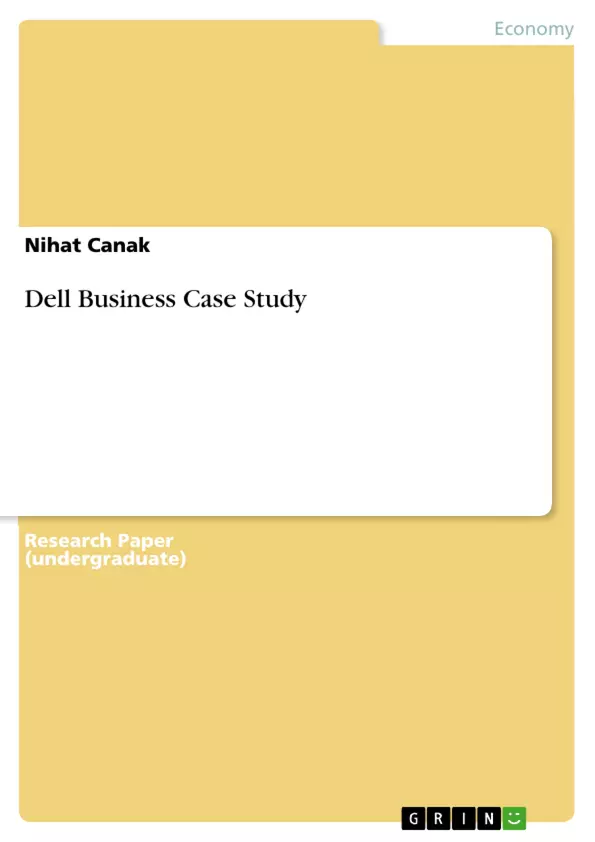Michael Dell founded Dell Computer in 1984. At the time he was only 19 years old, and in his first year of studies at the University of Texas in Austin. Michael Dell had a simple but powerful vision: that personal computers could be built to order and sold directly to customers. This followed from his belief that the PC, made up of little more than software from Microsoft and chips from Intel, was rapidly becoming a commodity product. Dell's new approach to the PC business had two advantages: (1) bypassing distributors and retail dealers reduced marketing and sales costs by eliminating the markups of resellers, and (2) building to order greatly reduced the costs and risks associated with carrying large volumes of both and finished goods. Michael Dell started his company with only US$ 1,000 of capital. DellComputer experienced its share of difficulties in the first few years, to the point where some family members and friends wondered whether it had been wise for Michael to drop out of university. Several times it had to refine its strategy even as it was implementing it. The company started off by using the direct sales model for upgraded versions of IBM-compatible PCs. However, within a year it was selling its own brands of PCs. Most of Dell's customers in the 1980s were hobbyists and experienced PC consumers.
Not surprisingly, Dell Computer was an early and enthusiastic convert to the Internet. It gained a first-mover advantage by setting up its first Web site in 1994, a year in which its total revenues were US$ 3.5 billion. By 1998, its Internet sales accounted for more than half of the firm's total revenues, which by then had surged to more than US$ 20 billion. At that point, Michael Dell had joined Bill Gates of Microsoft and Larry Ellison of Oracle among those who had become high-technology billionaires after dropping out of university. Michael Dell believes that his biggest challenge now is to have his company's direct business model as widely accepted outside the United States as it is across Dell's home market. He sees a need for aggressive marketing activities to develop customer trust and some modification of the basic model to account for institutional weaknesses and cultural differences in places like China and India. Michael Dell does not seem to be particularly concerned about the efforts of competitors to duplicate his build-to-order business model: [...]
Table of Contents
- Michael Dell
- Dell's Strategy
- Sales
- Production
- Procurement
- Outbound Logistics
- Service
- SWOT Analysis
- Competitors
- Competitive Strategy
- Financial Performance 2006
- Chances and Prospects for Continued Growth in Revenues and Earnings
Objectives and Key Themes
This case study examines the success of Dell Computer, founded by Michael Dell in 1984, and explores its strategy, competitive landscape, and financial performance. It delves into the company's direct model, its impact on sales, production, procurement, logistics, and customer service, and the challenges Dell faces in expanding its business model globally.
- The Dell Direct Model
- Competitive Advantage and Market Dominance
- Global Expansion and Market Challenges
- Financial Performance and Growth Strategies
- Impact of Technological Advancements
Chapter Summaries
Michael Dell
This section profiles Michael Dell, founder of Dell Computer, highlighting his vision of building PCs to order and selling them directly to customers. It details his early struggles, the company's evolution from selling upgraded IBM-compatible PCs to its own brands, and Dell's early adoption of the Internet. The chapter also emphasizes Michael Dell's focus on expanding the direct model globally and his perspective on competition.
Dell's Strategy
This chapter explains Dell's strategic approach, the Direct Model, which aims to understand customer needs and provide efficient solutions by eliminating retail intermediaries. It discusses the benefits of this model, including cost savings, reduced inventory, and the ability to offer customized systems with the latest technology. The chapter details the implementation of the Direct Model across various aspects of the business, from sales and production to procurement, logistics, and customer service.
- Quote paper
- M.B.A. Nihat Canak (Author), 2006, Dell Business Case Study, Munich, GRIN Verlag, https://www.grin.com/document/64770




